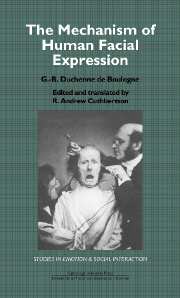Book contents
- Frontmatter
- Contents
- Acknowledgments
- Contributors
- Editor's Preface
- Part 1 The mechanism of human facial expression or an electrophysiological analysis of the expression of the emotions
- Preface
- A Introduction
- B Scientific section
- C Aesthetic section
- Foreword
- Chapter 17 Aesthetic electrophysiological studies on the mechanism of human facial expression
- Chapter 18 Further aesthetic electrophysiological studies
- Chapter 19 Synoptic table on the plates of the Album
- Part 2 Commentary chapters
- Index
Chapter 17 - Aesthetic electrophysiological studies on the mechanism of human facial expression
Published online by Cambridge University Press: 10 November 2010
- Frontmatter
- Contents
- Acknowledgments
- Contributors
- Editor's Preface
- Part 1 The mechanism of human facial expression or an electrophysiological analysis of the expression of the emotions
- Preface
- A Introduction
- B Scientific section
- C Aesthetic section
- Foreword
- Chapter 17 Aesthetic electrophysiological studies on the mechanism of human facial expression
- Chapter 18 Further aesthetic electrophysiological studies
- Chapter 19 Synoptic table on the plates of the Album
- Part 2 Commentary chapters
- Index
Summary
Plates 74, 75, 76, 77, 78
The faces of the aesthetic section will at first sight seem like mere grimaces to those without the key to my experiments. Thus I repeat that the isolated electrical contraction of the muscles that produce the different expressions on each side of a face can in fact only display a grimace, if we look at both sides of the face simultaneously. Therefore, as I indicate in the captions, care will be taken to cover this or that part of each of these faces, while we look at the opposite side; in this way we will see the expression of the face depicted completely, often becoming quite beautiful.
Plate 74: Portrait of a young woman in repose, following which the various expressions in Plates 75, 76, 77, and 78 were photographed.
Plate 75: General view: nun saying her prayers, with resigned suffering at left, and with only sadness at right. A sorrowful prayer, but with resignation by covering the eye, eyebrow, and forehead of the right side; a somewhat sad prayer, by covering the same parts of the left side.
The head alone: a painful or sorrowful memory, by covering the eye and forehead of the left side; a somewhat sad memory, by covering the same parts of the opposite side. […]
- Type
- Chapter
- Information
- The Mechanism of Human Facial Expression , pp. 104 - 113Publisher: Cambridge University PressPrint publication year: 1990

